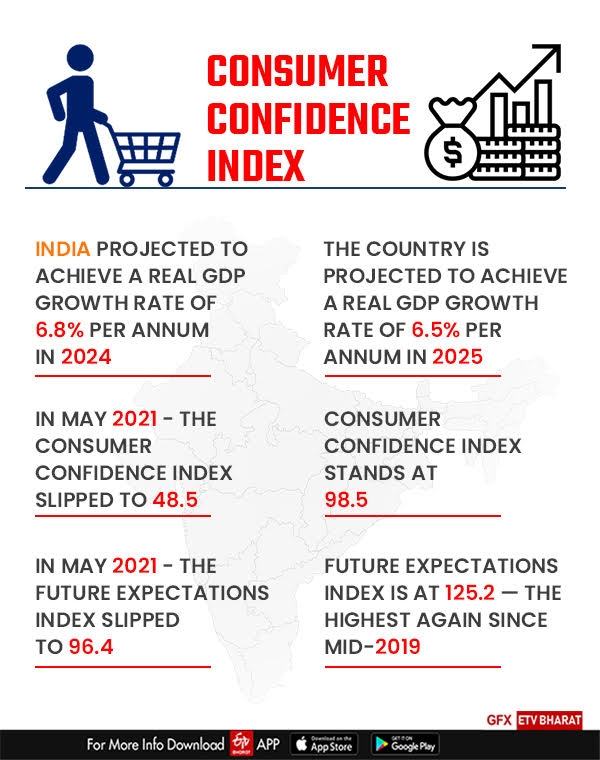Picture this: The BSE Sensex is on a bull run, having surged by almost 22 per cent— from 61,112.44 in April 2023 to 74,482.78 in April 2024 — reflecting a robust optimism in the Indian economy. This is corroborated by the World Economic Outlook projections for April 2024, which present a resilient India for the years 2024 and 2025, amidst the dismally low growth rates in the rest of the world.
Thus, India is projected to achieve a real Gross Domestic Product (GDP) growth rate of 6.8% per annum in 2024, followed by a slight deceleration to 6.5% per annum in 2025, figures that eclipse those of major economies, including China. However, the critical question remains: How "confident" can we be that the Indian economy will sustain these projected growth rates in the current year, as well as the following year? What would be the answer from policy makers, if for instance, Amitabh Bachchan in his popular TV show, were to ask them: "Confident? Lock Kiya jaye?"
It would appear that not enough attention is being paid to consumer confidence and its role in boosting the economy through bolstering sentiments of the Indian consumers. Such consumer confidence is tracked by the Reserve Bank of India (RBI) on a bi-monthly basis and comprises questions to a representative sample of respondents on their current perceptions (vis-à-vis a year ago) and a one-year ahead expectations regarding the general economic situation, the employment scenario, the overall price situation, own income and spending.

In this sense, the Consumer Confidence Index is a lead indicator, providing policymakers some sense of the future developments with regard to the households' consumption and saving. A score above 100 indicates optimism and a propensity to spend rather than save, whereas a score below 100 suggests prevailing pessimism.
The latest survey for India, conducted over the period March 2-11, 2024 covers 6,083 respondents across 19 cities, and interestingly had female respondents accounting for 50.8 per cent of the sample. The survey carries important insights regarding the future state of the economy. Consumers’ confidence regarding the current situation has improved and is at the highest level since mid-2019. In May 2021, this index had slipped to 48.5, which was the lowest in more than a decade, and currently stands at 98.5.
However, such confidence is still lower than the optimal threshold figure of 100, indicating pessimistic sentiments in the economy. Consumers seem to be far more confident of the year ahead, with the Future Expectations Index prevailing at 125.2 — the highest again since mid-2019. In May 2021, this figure had slipped into pessimistic territory, with a value of 96.4.
A deeper dive into sentiments reveals a mixed picture. The perceptions regarding the current economic situation, which have been negative between March 2023 till January 2024, have improved to become positive in March 2024. Perceptions regarding employment too which remained negative throughout March 2023 till January 2024, became neutral (zero) in March 2024, while those regarding both price level and inflation continued to remain negative even in March 2024, although the extent of negative sentiments had improved compared to the last round.
The perceptions regarding current spending, although positive, have deteriorated since November 2023 and stand at the same level as in September 2023. Consumers are optimistic about spending on essential items, while they continue to be pessimistic regarding spending on non-essential items. It is only in the perception regarding income that we can discern a clear optimism, with clear positive and rising sentiments prevailing since November 2023.
These trends seem to be supported by other incoming data. For instance, according to the data released by the government on April 26, 2024, the guaranteed rural employment under the Centre's Mahatma Gandhi National Rural Employment Guarantee Act 2005 (MGNREGA), which acts as the employment of the last resort in rural areas, has reduced in the financial year 2022-23.
Thus, the average employment days per household under MGNREGA slipped to 47.84 in FY 2022-203 — a five-year low. Another set of incoming data shows the business confidence, measured by the Purchasing Managers' Index, recording a high of 58.8 in April 2024. The April PMI value, although lower than the preceding month figure of 59.1, indicates business sentiments being bolstered by strong demand conditions, the best in the past three and a half years.
India is largely a consumption-driven economy, with 60% of the nominal GDP accounted for by consumption. Such consumption does depend largely on the consumers' disposable incomes. However, it also depends on consumer confidence, which becomes a pivotal factor causing dips in consumption during uncertain times, potentially deepening recessionary conditions which may be developing on account of other external conditions. Therefore, policymakers must remain vigilant and ensure that consumer confidence metrics are integral to their economic assessments and declarations.
Policymakers are well advised to keep their eyes on the ball and be confident when they state: Economy! Confident! Lock Kiya Jaye.



